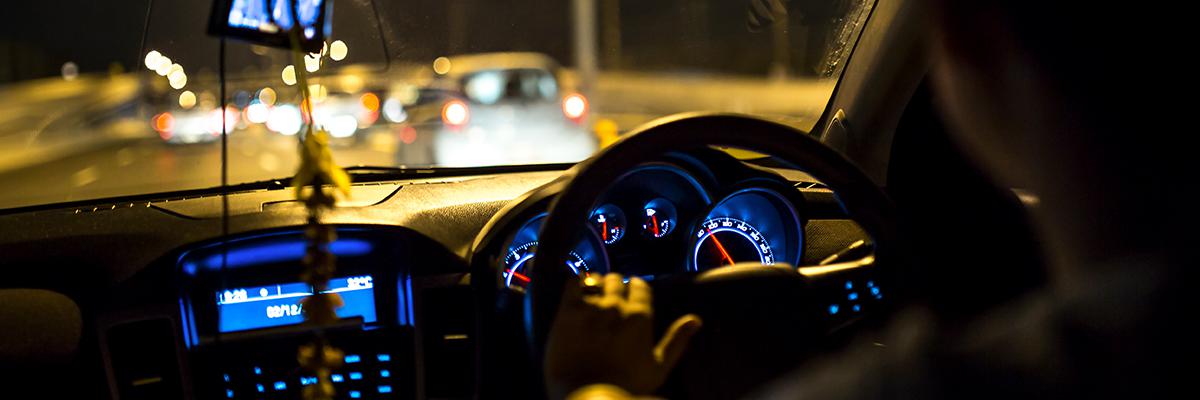
Book online or Freephone 0800 5244 780
Tips for driving at night
Whilst winter brings with it a whole host of weather problems that can hinder driving, it also brings reduced daylight meaning, ultimately, many journeys happen in the dark.
Driving in the dark can be difficult at times even for the most experienced motorists and is definitely more dangerous than travelling in daylight conditions. The Royal Society for the Prevention of Accidents (ROSPA) state that 40% of collisions occur during the hours of darkness and falling asleep at the wheel accounts for 20% of serious motorway and monotonous road accidents in Great Britain. Their data also shows a spike in the number of vulnerable road users killed or seriously injured each year when the clocks go back.
Reduced visibility is one of the main reasons that night driving is so hazardous. Streetlights provide some much-needed extra light, but since the introduction of part-night lighting, as many as seven out of ten councils have, or are planning to, switch lights off at night in a bid to not only reduce their carbon footprint but also make savings. This, combined with the inclement weather common in the winter months, provides the recipe for potential disaster.
The darkness also contributes to other factors that can hinder as well. Reaction times are slower, and it’s harder to judge speed. Depth perception, colour recognition and peripheral vision can all be compromised and the glare from oncoming vehicle headlights can also temporarily blind a driver.
With all this in mind, we’ve pulled together our essential guide on how to help you, and those road users around you, stay safe whilst driving at night. Whilst things can still go wrong when for driving in the dark, following this advice is sure to help towards reducing your risk whilst travelling after daylight hours.
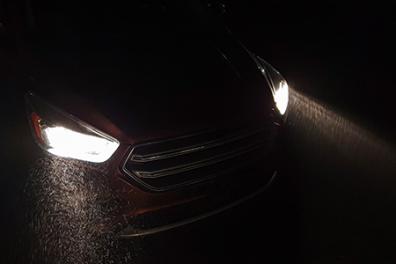 Using your lights correctly can stop you dazzling other road users
Using your lights correctly can stop you dazzling other road users
Use your lights correctly
It seems obvious but using your vehicle lights is not just about making sure they are turned on. IAM RoadSmart (formerly The Institute of Advanced Motorists) recommends you turn your dipped headlights on at least an hour before sunset and an hour after sunrise to make yourself clearly visible to other road users. Switch to full beam when on poorly lit roads but keep a lookout for oncoming vehicles and dip your lights appropriately to avoid dazzling the approaching driver. Use fog lights only when visibility is compromised. If you’re hiring a vehicle it is essential that you familiarise yourself with the lights before you start your journey.
Keep on top of maintenance
Checking your vehicle before every journey is probably not something most of us do regularly, but it is essential to safety. A hire vehicle will have had these checks performed as standard but for a vehicle you own yourself, you may not be as consistent. Bulbs can go and dirt can build up and both may be things you haven’t noticed, especially during the summer months when you have less use for headlights. Clean your exterior lights are check they are all working as they should be. It may also be necessary to adjust your headlamp aim as it can be affected over time or if you’ve had a new bulb fitted. Correct alignment is an important road safety feature that ensures the driver can see enough of the road both in the distance and in front. There are online articles that walk you through how to do it if you want to tackle this yourself. Alternatively, speak to your garage or take your car to a retailer such as Kwik Fit or Halfords.
Pay attention to your windows
If you can’t see, you can’t drive, so keep those windows as clear as you can. Glass at the front and back of the vehicle can collect dirt and condensation easily throughout the course of a journey so take the time to give them a clean each time you set off. Streaks can increase the glare from headlights so ensure you use a soft cloth to eliminate any after you’ve wiped over the glass. As windows have a habit of steaming up in colder weather, we tend to use heaters to clear them. These then blow out dirty air which can add a thin layer of grime to the glass. This haze can also add to the glare of oncoming headlights. We recommend you keep a soft dry cloth in your vehicle to wipe the inside of your windscreen on a regular basis. Scrapers and antifreeze are also a must for the colder weather. Never drive a car until the frost and ice has been completely cleared from your line of vision and be aware that the windows may cloud up as you begin to drive.
Visit an optician
Not everyone has good night vision – the ability to see well in low-light conditions – and, as we get older, it is generally more difficult to see well at night. For example, a 50-year-old driver may need twice as much light to see well as a 30-year-old and this only gets worse as the years go on. Driving during twilight can also be difficult as eyes have to constantly adjust to the reducing light. If you notice at any point that you have difficulty seeing signs or reading number plates, it is probably time to get your eyes tested. If you need to wear glasses whilst driving, speak to your optician about an anti-reflective coating on your lenses that may reduce glare when travelling at night. And remember to have regular checks to keep on top of any changes to your eyesight.
Take care
We all like to think our concentration is top-notch behind a wheel, but it’s not difficult to be distracted by even the smallest of things. Having passengers in the car, especially young children or even having the radio on can mean we lose our concentration for a millisecond, and that can be long enough for an accident to happen. Try and minimise anything that may mean you take your eye off the road. Keep internal lights off whilst driving at night as well and dim the dashboard lights if you can. The light inside can hinder what you can see outside and leave you open to missing something important. Reduce your speed to allow for slower reaction times and give yourself more time to do the journey so there is less need to rush. Planning your journey in advance is also a real positive when driving at night. If you have a sat nav go through the route to familiarise yourself as getting lost in the dark only adds to the already present danger. If you’re hiring a vehicle, find out about including sat-nav in the hire if the vehicle you are hoping to lease doesn’t come with one installed.
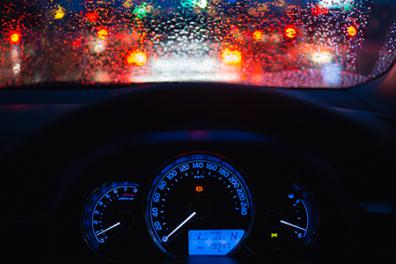 Internal lights can impede your vision at night
Internal lights can impede your vision at night
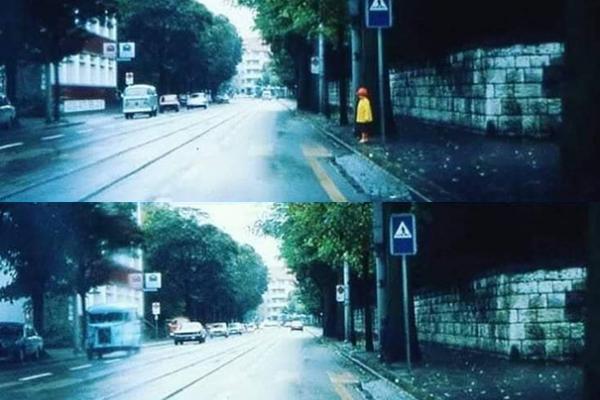 This image shows the difference clothes to can make to whether a pedestrian can be seen as the evening sets in
This image shows the difference clothes to can make to whether a pedestrian can be seen as the evening sets in
Be more aware
Pedestrians and cyclists are harder to spot in the darkness, especially if they’re not wearing reflective clothing, so be aware, especially when driving through built-up areas. Animals tend to come out more at night too, so look out for animal road signs – deer, otters, and frogs have signs alerting people that they cross the road – and stay vigilant, adjusting your speed if necessary. If you do see an animal remember it is your responsibility to not put other motorists in danger, so only stop or avoid it if it is safe to do so. Stay aware of the road in front of you as well. Look ahead for glimpses of light that could indicate oncoming traffic, bends and dips in the road as well as signs and other road users.
Coping with headlight glare
One of the hazards of driving in the dark is the dazzle of oncoming headlights which can be momentarily blinding. According to the RAC it is experienced by an estimated 16.1m UK drivers with 91% saying ‘some’ or ‘most’ car headlights are too bright and 54% are dazzled more regularly today than a year ago. Official government data shows there are around 300 collisions every year where dazzling headlights is cited as a factor, indicating it is a problem that every driver needs to be aware of. To help alleviate the impact of headlight glare avoid looking directly at the oncoming vehicle. Instead, keep your attention to the left-hand side of the road and follow the white line marking the edge if there is one to keep track of your position. If the glare is too dazzling, slow down but try to avoid decreasing speed abruptly if you have a car following you. It's better to travel at a slower, consistent speed rather than speed up and slow down continuously. On rural roads, drive on full beam whenever possible but dip your lights for an oncoming vehicle to avoid dazzling the driver.
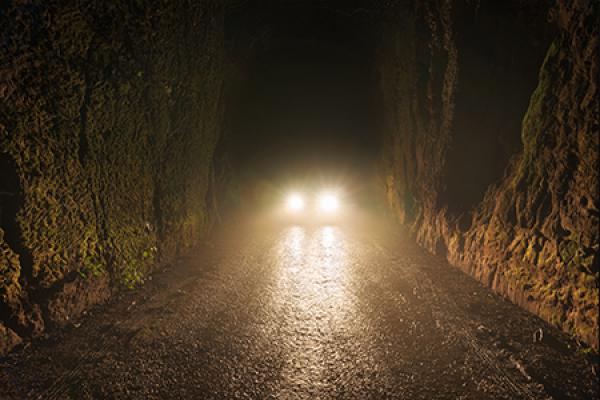 Avoid looking directly at an oncoming vehicle
Avoid looking directly at an oncoming vehicle
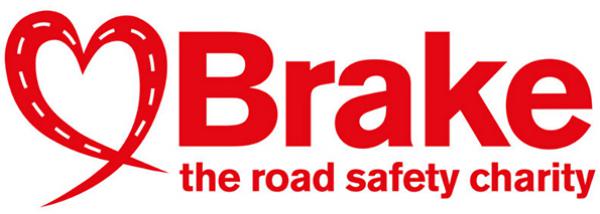 Brake – the road safety charity
Brake – the road safety charity
Stay fresh, stay alert
If you’re travelling for a period of time, it’s even more important to take regular breaks when driving at night. Fatigue is a major cause of crashes in the UK with BRAKE stating that 4% of fatal crashes in Britain are caused by tiredness with a further 13% of drivers admitting to falling asleep at the wheel. Monotonous road conditions can further aggravate this, so if your journey has a lot of motorways or dual carriageways, plan some stops to freshen up and grab a coffee.
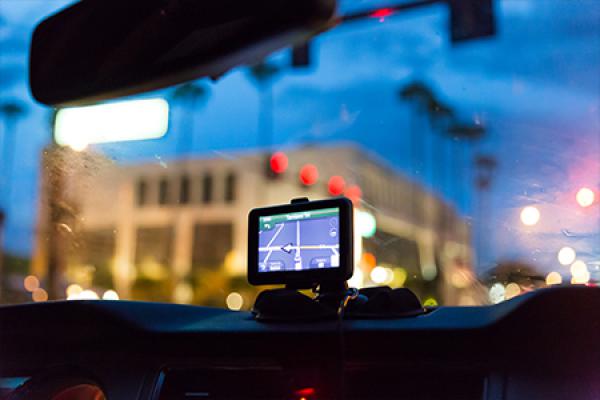 At Nationwide Hire you can hire a sat-nav along with a vehicle for an additional cost
At Nationwide Hire you can hire a sat-nav along with a vehicle for an additional cost
If you’re planning on hiring a vehicle and driving in the twilight hours, then make sure you speak to our team about your requirements. Nationwide Hire has a vast range of vehicles with the ability to add on extras such as sat nav and infant car seats. Our friendly team will also be happy to run through the vehicle controls and any other features that ensure your time with the vehicle is as safe as possible.
Give us a call on freephone 0800 5244 780 or speak to one of our friendly advisors online between the hours of 8 am and 6 pm Monday to Friday or 8 am and 5 pm Saturday and Sunday.
